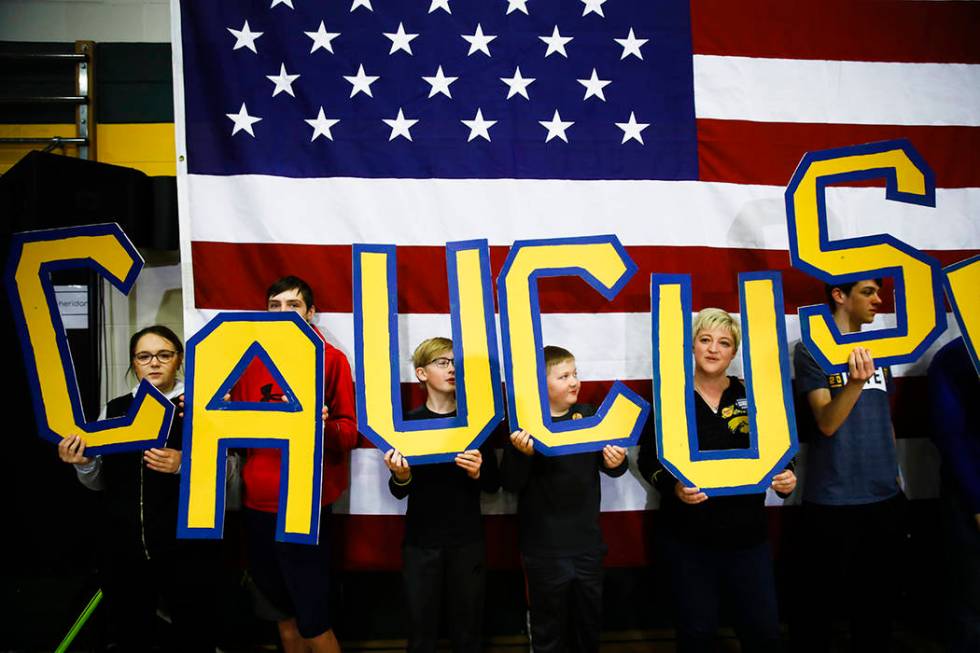Part shrink, part math whiz, part politico: Training for Nevada’s caucus

As the Nevada Democratic presidential caucuses approach, hundreds of people are packing tiny rooms in Las Vegas strip malls to train as precinct captains, a volunteer role unique to the caucus system.
Precinct captains act simultaneously as persuaders and police force for their chosen candidates.
About 30 people sat elbow to elbow at one such meeting Monday in a room painted to resemble a rainbow with “PETE” emblazoned in white, training under Travis Brock, the top caucus stragetist for former South Bend, Indiana, Mayor Pete Buttigieg.
Brock, a campaign veteran and former executive director of the Nevada Democratic Party, spent more than an hour acting as part political operative, part math teacher and part psychology professor for Monday’s crop. He trained his listeners in persuasive techniques and empathizing with undecided Democrats while also drilling them on the formulas used to calculate the all-important delegate totals.
As Brock spoke, a similar training was happening just a few doors down at an office for Sen. Bernie Sanders’ campaign. With New Hampshire’s primary soon to be in the rear-view mirror and Nevada early voting beginning Saturday, these campaign boot camps have ratcheted up in intensity and frequency.
These sessions serve three key roles for campaigns seeking to win a caucus: providing a steadying presence for existing supporters who may not fully understand the complex rules and processes of a caucus; recruiting displaced supporters of “nonviable” candidates, which are those who do not reach 15 percent of the total vote, during the crucial 15-minute realignment period; and monitoring Nevada Democratic Party volunteers on behalf of the candidate to ensure the counts occur fairly and accurately.
“One of the great things about a caucus is it’s all out in public, and we all hold each other accountable for each other,” Brock said.
Brock held similar trainings in Iowa, where Buttigieg claimed victory in the close, bitterly contested caucuses by earning 13 national delegates to Sanders’ 12, though Sanders secured more overall votes. He noted that precinct captains caught and corrected several errors as technical problems imploded the Iowa caucuses.
The basic math used to award thousands of county delegates, which ultimately boil down to the state’s 36 pledged national delegates, is actually somewhat simple, Brock explained.
Captains need to know three numbers: how many people are in their preference group, how many delegates are awarded at that particular caucus location and how many total voters attended the caucus, including early voters.
The first two numbers are multiplied together, then divided by the third to decide delegate allotments, with a few caveats, including that every viable candidate must receive at least one delegate.
The tricky part comes in the rounding.
During the first alignment, caucus officials will add up the total number of voters present, then calculate what 15 percent of that number is. Should that number have a decimal point, it will always be rounded up, as you can’t have a percentage of a person supporting a candidate.
However, during the second allotment to decide delegates, traditional rounding rules apply. If Buttigieg were to win 4.2 delegates, for example, that would round down to four delegates in almost all scenarios.
The group appeared attentive during the lessons. At one point during the math lesson, one woman nodded before speaking out.
“This is how we beat Bernie in the delegates,” she said.
Contact Rory Appleton at RAppleton@reviewjournal.com or 702-383-0276. Follow @RoryDoesPhonics on Twitter.